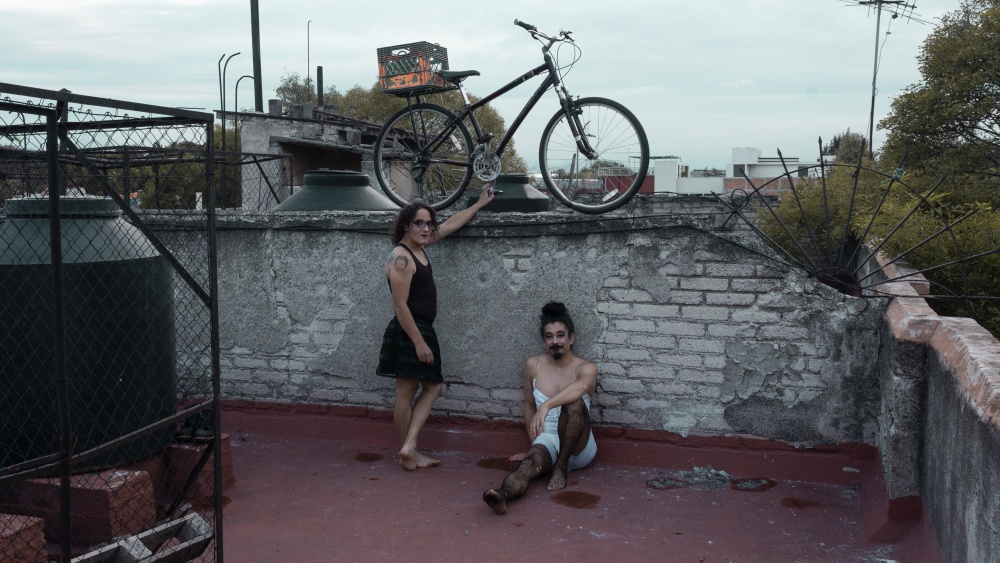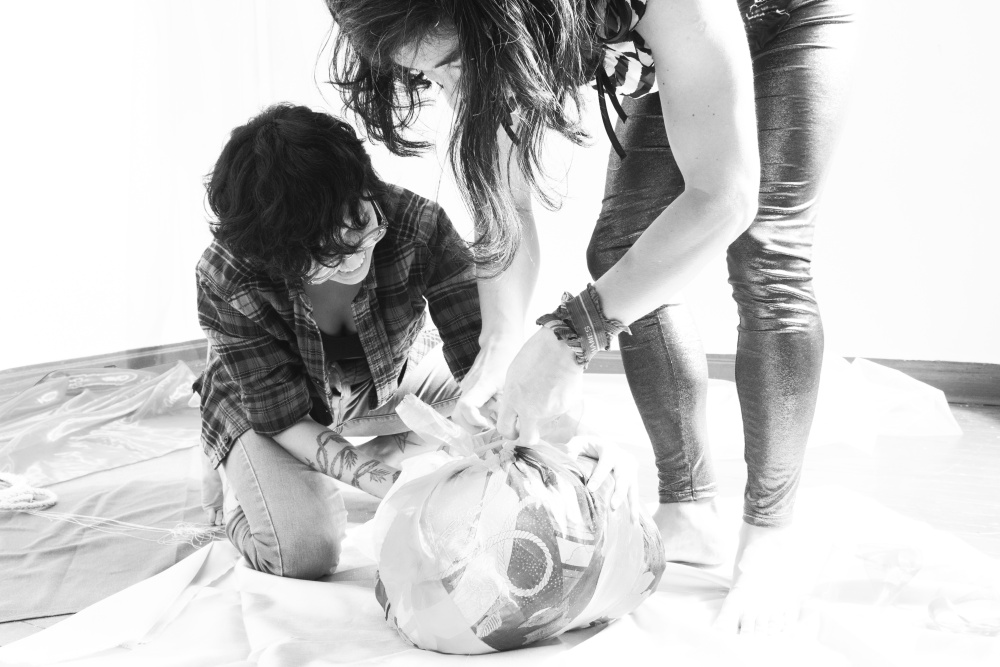Fernando Fuentes is a nonbinary Mexican artist whose new work explores masculinity and gender and sexual dissidence during a moment of profound patriarchal violence in Mexico.[1] They first emerged onto the Mexican artistic scene as a performance artist at the end of the 1990s. In the early 2000s, Fuentes and their collaborator, Lorena Méndez, transitioned their work away from strictly artistic venues and began to work in the Mexican prison system in a project known as La Lleca. This ever shifting collective of artists, therapists, anarchists, and intellectuals—in which I participated between 2005 and 2008—became known for its nontraditional, experimental, and exploratory collaborative work with incarcerated and formerly incarcerated individuals around thematics of gender, masculinity, and sexuality. In 2008 La Lleca published an overview of some of their methodologies and experiences in Cómo hacemos lo que hacemos (JUMEX, 2008), and in 2019 they celebrated their fifteenth anniversary in the Museo Universitario Arte Contemporáneo (MUAC).
In 2018 Fuentes began a new project, Antiescuela para las disidencias sexuales y de género (Anti-School for Sexual and Gender Dissidence). The Anti-School is a set of evolving laboratories, or anticursos (literally, anticourses), located at the edges of or completely outside institutional spaces and is dedicated to exploring the production of masculinity and dissident genders and sexualities through practices based in affect, performance, and community. The Anti-School aims to produce insurgent, anti-patriarchal, feminist knowledges for collective transformation. One workshop used writing-based practices to explore dissident bodies and the military-patriarchal order; another, a collaboration with Ultra Red, was a collective listening action that investigated the role of sound in the construction of patriarchal hegemony; in a further iteration, the Anti-School met on a street corner outside the Universidad Autónoma de la Ciudad de México, allowing passersby as well as students to stop, share, and participate in conversations about masculinity and gendered violence. As a continuation of this project, Fuentes’s most recent work (2020–present) has turned to photography, working in concert with trans, nonbinary and gender-nonconforming comrades, friends, and artists, to document what they call “flights from masculinity” and “anti-patriarchal worlds.”
I have authored the following pieces—a continuation of our previous collaborations—as a set of excursions into and reflections on Fuentes’s photographs. They supplied me with the archive of photos that form the project, and I chose four that exemplified its spirit. In the same collaborative and experimental ethos as the photos themselves, these short aphoristic texts use the space the photos open up to think across gender formations and queer lifeworlds. I begin the first piece with a consideration of Jack Halberstam’s Female Masculinity (2018), which serves as one of Fuentes’s key interlocutors for this project, and from there weave together my reflections and additional citations to investigate the colonial-patriarchal matrix of gender and the openings Fuentes’s work provides us into anti-patriarchal worlds of our desired future.
I.

In an interview on their book Female Masculinity, Jack Halberstam notes that “femaleness does not automatically produce femininity and maleness does not produce masculinity.” However, “masculinity has an altogether different relation to performance, the real and the natural and it appears to be far more difficult to pry masculinity and maleness apart than femininity and femaleness.”[2] In worlds torn apart by patriarchal violence and feminicidio, is the fit even tighter, the lock more difficult to pry open? What does it mean for bodies, subjectivities, and individuals to transit through, toward, or away from masculinity and gendered violence? In the same interview Halberstam offers a way forward, drawing on Gayle Rubin’s idea of “sexual ethnogenesis,” or how sexual communities form: “I think scientific discourses have tended to narrow our ability to imagine sexuality and gender otherwise and in general the discussions that take place in medical communities about embodiment and desire may be way behind the discussions taking place on email lists, in support groups and in sex clubs. . . . Nowhere has this been clearer in recent years than in relation to the experience we call ‘transgendered.’” On an azotea (rooftop) in Mexico City, our gaze is returned by two figures who have turned to notice us. Their presence—calm with a hint of curiosity—opens toward us; their connection is not broken by our looking, but rather they invite us across the transom of community. As the wall supports the curve of one body and another figure holds a bike aloft, they offer a similar care and repose, a place to look back from, a respite from the street battles below. Their return of our gaze pulls us into a space of experimentation, for the draping and layering of codes of gender, of bodies in relation, of collectivity and experience. A space for the composition of transits through gender marshaling themselves against necro-political misogyny.
II.

What is the place of insurrection in queer life? The editors of Bash Back write: “We’re here to destroy what is destroying us. Let’s be speaking of revolt. We are tracing the lineage of our queer criminality and charting the demise of the social order.”[3] Lineages of liminality, ones that stretch back to the pre-conquest. María Lugones describes how colonization imposed biological gender as a structure of domination: “Oyeronke Oyewumi shows us that the oppressive gender system that was imposed on Yoruba society did a lot more than transform the organization of reproduction. Her argument shows us that the scope of the system of gender imposed through colonialism encompasses the subordination of females in every aspect of life.”[4] Non-Western gender matrices and practices like the muxes still exist, and their existence is a reminder that many have fought to persist, their insurrections are the basis of those of the present. If history and intimacy are two enduring themes of queer art, here the histories of these past struggles are held in the warmth of shared intimacy. The bottles are clean, the gasoline canister new, this insurrection is filled with hope and difference. The wick becomes a garment, the Molotov becomes a part of the body, and the material practice of gender nonconformity finds a political expression in the material practice of preparation for a battle in the street. One front of this insurrection is against gender-critical feminism, which has found root in Mexico, where the phrase “abolish gender” (abolir el género) is code for a politics of hate against trans, nonbinary and gender-nonconforming people. In the conspiracy against the coloniality of gender, there are whispers of another abolition, that of the abolition of the existing order of things, where difference proliferates at a barricade instead of dying on it and where ancestors sense and share the joy of mixing bodies and history.
III.

The past weighs like a nightmare in the minds of the living. How do we twist out of our present without spiraling, without shattering? We do not choose our histories, yet we also fight for a different relationship to them. The solitary work of redefinition, of binding, of bulking, of mulching the past—which we see here as two individuals cut apart and then bind together their overly gendered childhood clothes—becomes joy when held with another pair of hands. The transference into the collective: the unexpected relief of a once solitary suffering seen as shared. A bundle is most often a burden, a weight to be carried. Here, in queer dialectics, it is the burden of forced history transmuted into a bundle that dissipates the weight. A mass lighter than the sum of its pasts. Siobhan Guerrero says we must make masculinity, either as a past or a destination, inhabitable. Hold these two sides together for a moment. There is hope; there is terror. Hope because the world is not enough; terror because we may not be enough either.
IV.

Being held in uniqueness not as an essence but as a process, as movement. Sensuous delight in accompanying the manifestations of each soul’s movement. In those transitions one shimmers with transparency. Queer love is being held, not just by hands but by a common light, which reminds us why these particular bodies resonate. Rita Segato writes, “The first victims of the masculinity mandate are men: forced to bend to the corporate pact and to obey its rules and hierarchies from the moment they enter life in society. It is the family that prepares them for this. Initiation to masculinity is a very violent transition. That violence will later return into the world. Many men today are withdrawing from the corporate pact, marking a path that will transform society. They do it for themselves, first of all. Not for us [nosotras]. And so it should be.”[5] Love is disobedience, and as such the first insubordination is love of self. To survive and to build a world that is more than survivable, that is inhabitable, we must disobey the command and open a new transit, outside empire, a transit lit by the light that only knows how to join the warmth of our figures, not render or dismember.
Luis Fernando Fuentes Sánchez is a Mexican queer artist and activist. In the last seventeen years, they have performed mainly in jails and spaces of social and political resistance as part of La Lleca collective. Previously, they presented their performance art pieces in museums and galleries. In 2018 they started the Anti-School for Sexual and Gender Dissidence. Fuentes is currently part of the Sistema Nacional de Creadores de Arte (SNCA).
Brian Whitener is an assistant professor of Spanish at the University of South Alabama and the author of Crisis Cultures: The Rise of Finance in Mexico and Brazil (2019). Other projects include Face Down (2016); De gente común: Prácticas estéticas y rebeldía social, edited with Lorena Méndez and Fernando Fuentes (2013); and the translation of Grupo de Arte Callejero’s Thoughts, Practices, and Actions (2019) with the Mareada Translation Collective.
The author would like to thank Marie Buck, Matthew Walker, Joey Yearous-Algozin, and Fernando Fuentes for comments on this piece. Thanks to Nicole Archer for expert editorial work.
[1] Cristina Rivera Garza, Grieving: Dispatches from a Wounded Country (New York: Feminist Press, City University of New York, 2020); Alicia Gaspar de Alba and Georgina Guzmán, eds., Making a Killing: Femicide, Free Trade, and La Frontera (Austin: University of Texas Press, 2010); Sergio González Rodríguez, The Femicide Machine (Los Angeles: SemioText[e], 2012); and Rita Segato, La guerra contra las mujeres (Madrid: Traficantes de Sueños, 2016).
[2] “Masculinity Without Men: Annamarie Jagose Interviews Judith Halberstam About Her Latest Book, Female Masculinity,” Genders 1998–2013, April 1, 1999, accessed September 21, 2021, https://www.colorado.edu/gendersarchive1998-2013/1999/04/01/masculinity-without-men-annamarie-jagose-interviews-judith-halberstam-about-her-latest.
[3] Fray Baroque and Teagan Eanelli, eds., “Queer Ultraviolence: Bash Back! Anthology (Libcom.org, 2016), accessed Sept 21, 2021, https://libcom.org/library/queer-ultraviolence-bash-back-anthology.
[4] Maria Lugones, “The Coloniality of Gender,” Worlds & Knowledges Otherwise (Spring 2008), accessed September 21, 2021, https://globalstudies.trinity.duke.edu/files/ documents/v2d2_Lugones.pdf.
[5] Rita Segato, Contra-pedagogias de la crueldad (Buenos Aires: Prometeo Libros, 2018).

